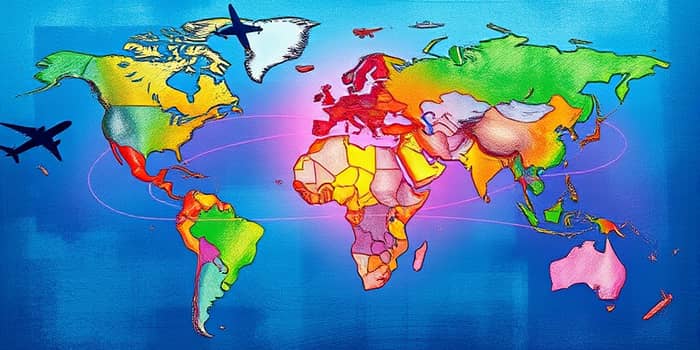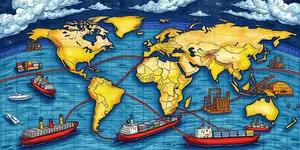
International commerce surged to an all-time high in 2024 but the momentum has proven fragile. Despite the headline figure of $33 trillion, growth decelerated markedly toward year-end, underscoring an uneven recovery shaped by regional divides, policy headwinds and shifting sectoral dynamics.
Global merchandise and services trade combined to hit record $33 trillion in 2024, up 3.7 percent or roughly $1.2 trillion over the previous year. Yet in the second half of the year, goods trade expanded by less than 0.5 percent while services climbed just 1 percent.
Looking ahead, the WTO forecasts a 0.2 percent contraction in global merchandise trade for 2025, with risks of a deeper 1.5 percent decline should geopolitical tensions intensify. The IMF recently revised its forecast down to 1.7 percent growth, highlighting growth slowed sharply in second half and leaving economists concerned about sustained recovery.
Across North America, Europe and Asia, outcomes are diverging dramatically. In North America, exports are exports projected to fall 12.6% in 2025, yet the U.S. saw a temporary first-quarter rebound with exports up 3.5 percent and imports surging 19 percent as businesses rushed to beat announced tariffs.
Europe endured negative growth overall in 2024, although early 2025 offered mixed signals: U.K. exports rose 4.7 percent, the EU as a bloc saw a 2.8 percent gain, Italy 3 percent, and Germany only 0.8 percent. This patchwork reflects varied fiscal stimuli and industrial strategies across member states.
In East and South Asia, developing economies led the global expansion. Their combined imports and exports grew 4 percent in 2024, driven by strong factory output and robust consumer demand. China’s exports rose 1.1 percent in Q1 2025 even as imports fell 3.7 percent, illustrating imports and exports up four percent in fast-growing markets.
Services trade outperformed goods in 2024, expanding 9 percent and adding $700 billion to the global tally. Goods rose a more modest 2 percent, contributing $500 billion. This divergence reflected stronger demand for digital and travel services as economies reopened.
However, Q4 2024 saw services growth slow to 1 percent and goods to under 0.5 percent. In Q1 2025, G20 service exports dipped 0.7 percent while imports climbed 1.0 percent, underscoring ongoing turbulence in service trades as supply chains and consumer behaviors adjust.
The U.S. trade deficit with China widened to $355 billion in Q4 2024, up $14 billion, while the deficit with the EU grew to $241 billion, an increase of $12 billion. Meanwhile, China’s trade surplus reached a post-2022 high, and the EU posted an overall surplus for 2024, reversing years of deficits.
These imbalances drive significant capital movements and currency pressures. The U.S. dollar’s strength has weighed on emerging market exports, challenging exporters in Latin America and Southeast Asia despite favorable commodity prices.
Several factors lie at the heart of the uneven rebound:
The IMF warns that protective tariffs and policy uncertainty inflict negative supply shocks, divert resources into less competitive sectors and dampen innovation. WTO Director-General Ngozi Okonjo-Iweala cautioned that enduring uncertainty could act as a brake on global growth, particularly harming vulnerable economies.
Despite risks, the opening quarter of 2025 offered glimmers of resilience. G20 merchandise exports rose 2.0 percent and imports 3.1 percent. Industrial freight indices began to plateau, suggesting stabilization after a period of volatility.
Freight volumes and shipping rates signal potential headwinds ahead, hinting at freight indices signal industrial slowdown that may weigh on trade if consumer demand softens further or if new restrictions emerge.
Developing economies outpaced their developed counterparts in 2024, but least-developed and export-dependent countries remain at greatest risk. Sudden tariff hikes or border restrictions can quickly undermine fragile recovery efforts.
Workers in import-competing industries face job losses, while wage pressures fluctuate. Without targeted support, uneven effects on jobs and wages could exacerbate social tensions in regions already struggling with high unemployment.
Aggregate growth and trade have long marched in tandem, yet recent shocks have fractured this historic link. Policymakers and businesses must embrace flexibility to navigate uncertain terrain. trade resilience requires strategic adaptation through innovation, diversification and collaboration.
By fostering cooperation, reducing policy unpredictability and investing in human capital, stakeholders can close gaps and build an inclusive recovery. collective action can restore balance in global trade, ensuring that the next chapter of commerce is defined by shared prosperity rather than division.
References













